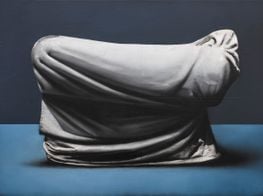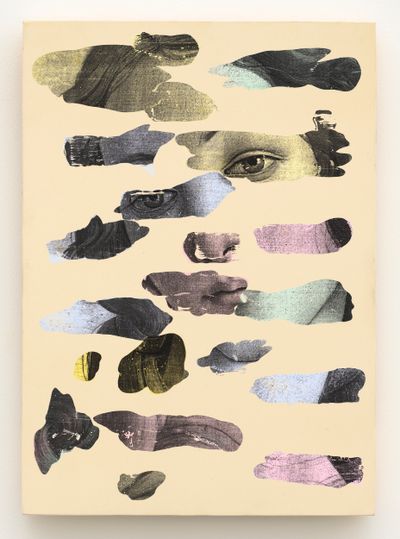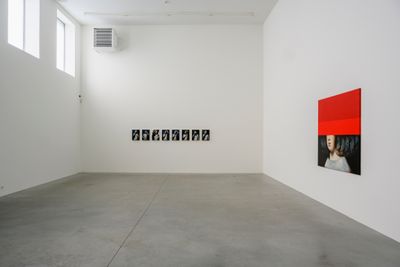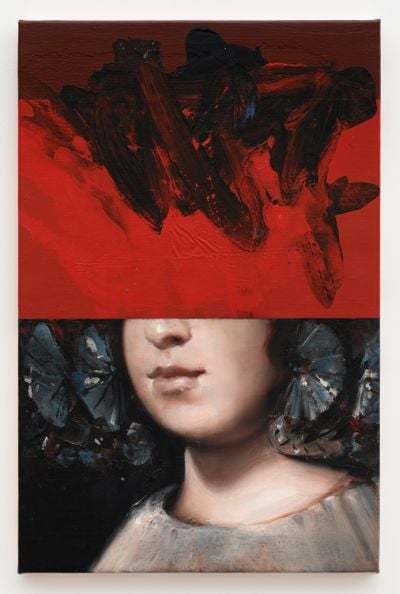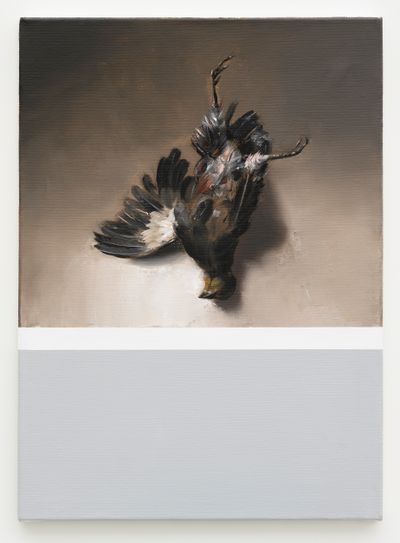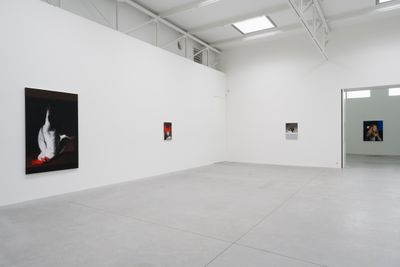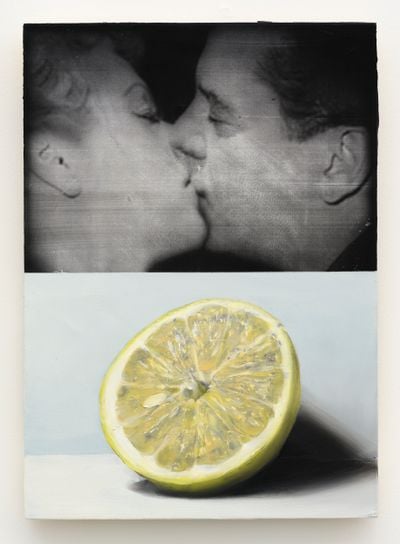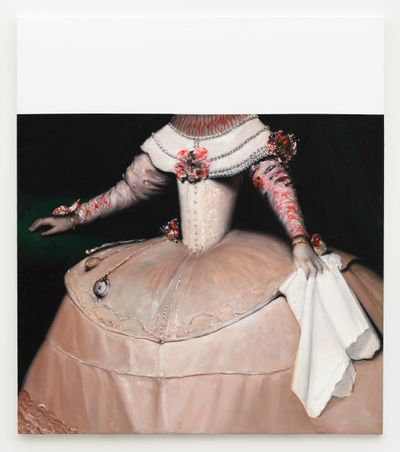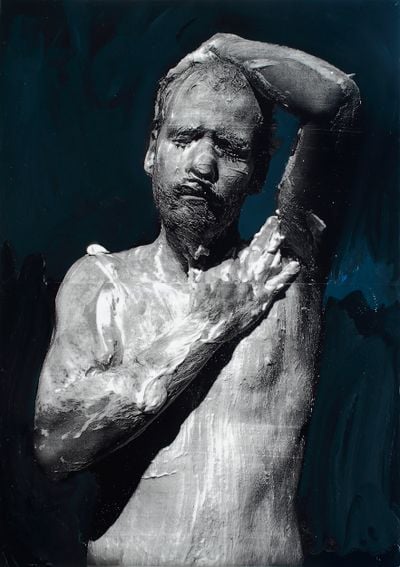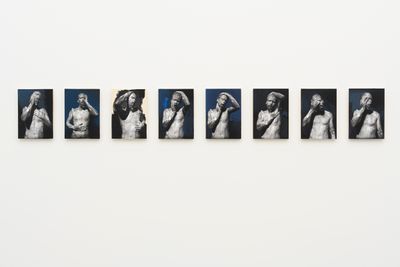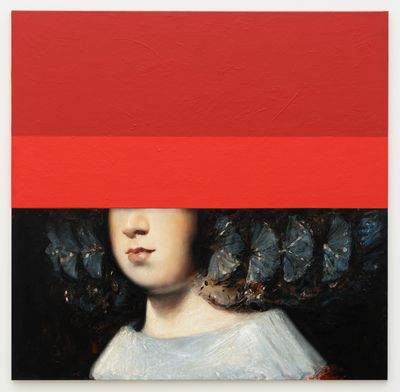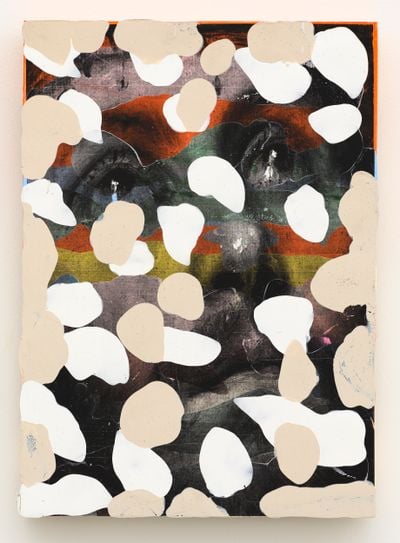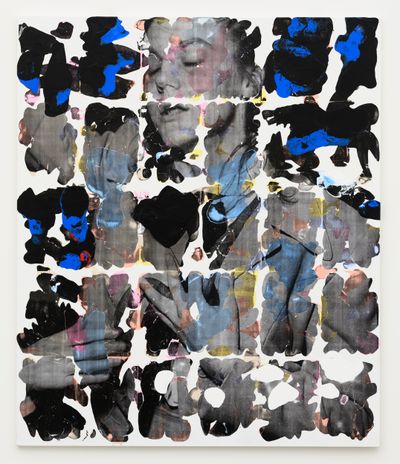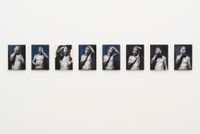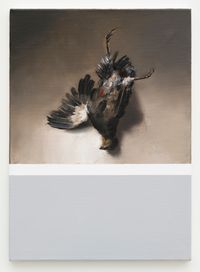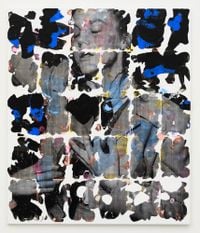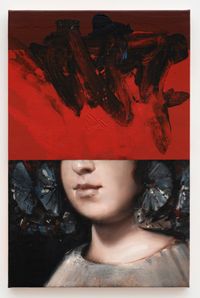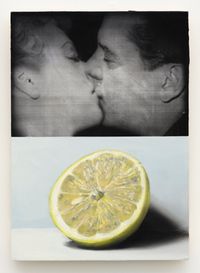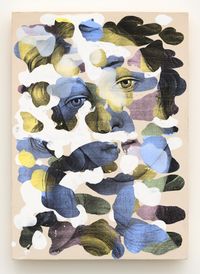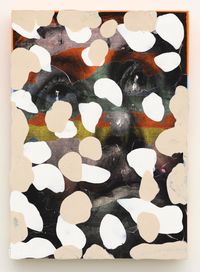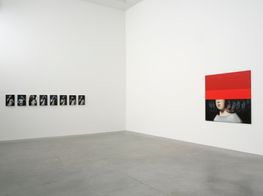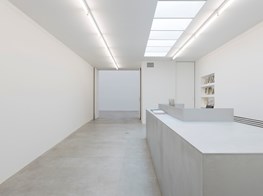Mircea Suciu Captures the Psychological Undercurrents of Now
Zeno X Gallery, Antwerp | Sponsored Content
Mircea Suciu. Courtesy the artist. Photo: Cornel Lazia.
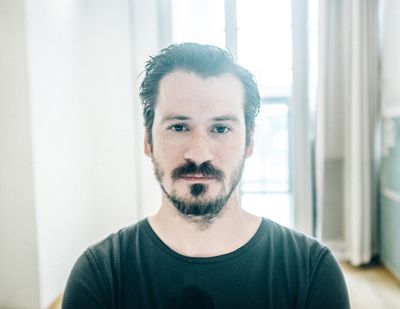
Mircea Suciu. Courtesy the artist. Photo: Cornel Lazia.
Throughout Mircea Suciu's paintings, an eerie atmosphere reigns. Figures portrayed with their heads concealed or in various states of distress feature alongside revisions of famous paintings, including Botticelli's The Birth of Venus (1485–1486) and, in the case of his most recent exhibition at Zeno X Gallery in Antwerp (Bleeding Heart, 1 September–23 October 2021), Las Meninas (1656) by Diego Velázquez.
'All our mistakes build history, and we evolve because of our mistakes,' the artist explains. 'My philosophy about humanity and evolution is encoded in my process.' Mining humanity's progression—and regression—involves, for Suciu, mining images across time.
Having embarked on a career in advertising after graduating from the University of Art and Design in Cluj, Romania in 2001—just over a decade after the fall of Nicolae Ceausescu's communist dictatorship—Suciu's access to popular imagery resulted in early works that incorporated news imagery.
Dust to Dust (2010), for instance, which was shown at the 2014 Gwangju Biennale, comprised 50 drawings of uprisings around the world in an installation that scaled the walls, overwhelming viewers in a collision of imagery.
Recently, Suciu explains he is pursuing a more subtle approach, noting that the more factual the images are, the less there is room available to reflect upon them. Instead, he engages with a monotype process that he learned during a year in Italy studying painting restoration, translating images using plastic printed sheets before they are built up once more on linen.
The aim is to create as strong an image as possible, approaching light and composition in ways that are characterisic of photography, allowing certain details to be more visible than others, as well as stressing sections of the image to visually indicate the passage of time. In the case of his reproductions of Las Meninas showing at Zeno X Gallery, Suciu is aiming for an entry point to discuss topics including the violence of imperial expansion. In America (after Velázquez) (1) (2021), the top half has been engulfed in a coat of blood-red paint, calling attention to the histories of violence associated with Spain's colonial empire.
In this conversation, Suciu expands on his pursuit of more subtle ways to capture the psychological undercurrent of the times, including learning from art history and embracing an honest approach to art-making.
TMI wanted to start from the very beginning with your studies in restoration of Baroque paintings. How did that inform the beginning of your approach to painting?
MSI received a grant to spend a year in Sicily and Palermo, where I studied etching, painting, and restoration, and assisted the process of restoring a huge classical Baroque painting of great importance.
I abuse the surface of my paintings to underline the effects of time on us. I am mirroring humanity. My aim is to discuss the frailty of humanity with all its issues.
I only understood the influence of this on my work later on in my life. My technique is eclectic. I like to work on linen, paper, all kinds of materials, but I also enjoy painting and working with volume.
I started working young. I was triggered by the death of my father when I was 13. I began painting as a form of therapy and never stopped. I am addicted to working and creating images.
When I work with the monoprint process, I use these plastic printed sheets to translate an image from one medium to another, using acrylic. The process has imperfections. The representation is flawed, and I use the process of restoration to build the new image.
My aim is not only to restore it, but to improve it. I want to arrive at a strong image that has the qualities of painting as well as the compositional control that is present in photography.
TMYou mention perfection, but your process also involves stressing the images once they are complete. Is that to amplify the art historical weight of these images?
MSI am abusing the surface when I'm not happy with the process. In doing so, the colours tend to be more transparent. You can observe the structure in the background. I enjoy this effect, which might be considered cheesy, but I'm aging the work to allow the viewer to see the effect of time on the surface of the image.
I had a show in New York called Universal Fatigue (Blain|Southern, 16 January–22 February 2020). The title is a notion is borrowed from physics. It means all matter on earth will eventually be destroyed.
I abuse the surface of my paintings to underline the effects of time on us. I am mirroring humanity. My aim is to discuss the frailty of humanity with all its issues.
Yesterday, I found out why diamonds are precious. It's not because they are perfect. It's because they are flawed. The flaw in the gem is what adds value. It's the same with art and humanity. All our mistakes build history, and we evolve because of our mistakes.
My philosophy about humanity and evolution is encoded in my process. I am not trying to make it complicated, this is my take.
I am a keen observer of social and political realities. It's not only my passion. It's my job as an artist.
TMYou talk about time, and your earlier works were dealing with news imagery, which encompass a very fleeting notion of time.
MSIt's related to my early interests. After university, I was totally broke. From Cluj, I went to Bucharest. I wanted to live in a big city.
I was freelancing in advertising, and I discovered photographic archives such as Getty. Working in advertising made me more accurate. I understood what a brief was and I discovered that I needed a logical way to approach the image, otherwise it would fall flat.
Returning to the earlier works that you mention that deal with social and political imagery, these days, my approach is more subtle. When the imagery is so factual, you stop reflecting on it.
For Bleeding Heart at Zeno X Gallery, most of the images are representations of Las Meninas by Velázquez. Some would say it is a bit passé, that it's a bit late to make or discuss that image. But images such as these have allowed me to go back to the roots of racism.
As a white man, it is difficult to discuss these things. I feel like I am entitled. But I am entitled to discuss these issues from my European perspective.
The Spanish Empire was, in my opinion, guilty for the massacre of the Indigenous peoples and their culture in both Americas. I produce these objects for the viewer to reflect on this issue. I am playing with the subject to make people reflect on these issues and how things came to this point.
I am a keen observer of social and political realities. It's not only my passion. It's my job as an artist. You cannot only make pieces that look nice in a living room. You have to be involved.
Yet after a while, you get tired of showing and discussing obvious situations. I wanted to refine my take on the issues that interest me.
TMYou have inserted yourself into recent self-portraits, a selection of which were exhibited at SAC Bucharest earlier this year (The Light of Recent Events, 31 October 2020–27 February 2021).
MSI call them my corona paintings. All painters have a corona series [laughs]. At first, I thought it was an easy take on this obsession with hygiene, but it is also related to humanity and all its mistakes.
Watching the news and watching this increasing tension in the United States made me think about collective guilt. We are all involved in this society and responsible in one way or another. It's related to religion and my own issues.
I suffer from anxiety, and these intense feelings are felt by me a bit more intensely than the average person. I felt the need to express this concern through the ritual of cleaning.
TMIt looks like you are covering yourself in paint.
MSIt was shaving foam. It was performative. I asked my wife to take the shots for me.
TMYou have referred to yourself as an image creator rather than a painter in the past, and these paintings made me think of that comment, whereby you are embedding yourself in the process of image creation.
MSI am obsessed with arriving at a strong image. The technique does not matter. I am using all the tricks to arrive at a strong image.
TMDuring the period you worked in advertising, you were dealing with imagery, but the way images are being disseminated right now is very different to ten years ago, particularly during lockdown, where partaking in a social movement often means sharing an image on social media.
There's a performative aspect to it. I was interested to discuss that in relation to your previous work, which was concerned with the loss of individuality that happens during mass movements, including demonstrations. How has this shifted for you in recent years?
MSAlthough I was young, part of my childhood was spent under a communist dictatorship. The 1989 Romanian Revolution really was televised, and after the war, I participated in protests related to social and political issues.
Kierkegaard has this expression regarding the 'dizziness of freedom'. When you are in a crowd, you lose your identity. You become one with the crowd. These issues are eternal. With or without new technology, people behave the same way.
I have addressed the issue for a while. I am not attracted to it anymore. I am more interested in discussing other topics. To show my weaknesses. To talk about my anxieties. With the pandemic, a huge part of the population started experiencing anxiety. It feels more honest as a topic.
TMI was curious to learn more about your monotype process. There are elements in them that recall digital technologies. The coloured bars in your take on Boticelli's Venus (2021), for instance, resemble television static.
MSWhen I was young, the government allowed us to watch an hour and a half of television, 20 minutes of news, and hymns about the glory of the dictator and his achievements. When the transmission was cut off, coloured bars appeared. I borrowed from this subconsciously.
When I made them, I wanted to develop a relationship between representation and abstraction. There are at least two distinct directions within abstraction: a more expressionist take and a rational, geometric take. I went for the geometric take.
My use of this colour palette draws from the movement of Orphism. I wanted to include colour and create rhythm. To include this relationship and build this structure. To show the relationship from the influences I suffered during my formation as an artist.
TMYou graduated from university with artists such as Adrian Ghenie and Victor Man, who were part of what has been retrospectively called the Cluj School. Having previously taught painting, what changes do you perceive in the work of young artists today?
MSOur teachers were not wise enough to give us the right push. They knew less than the students. When I arrived, I knew more about art history than the teacher. My family was in love with art.
My philosophy about humanity and evolution is encoded in my process. I am not trying to make it complicated, this is my take.
The term Cluj School was given by the editor of Flash Art, Giancarlo Politi. Victor Man, Adrian Ghenie, Marius Bercea, and I were friends. We worked together and exhibited together during a time when there was no art industry in Romania. We were exhibiting where we could, in any condition.
The term was generalised because we were from the same generation and lived together. It's not like the Leipzig School, where there is a distinct, shared style. We are completely different from one another. We were just connected by the pleasure of making art.
During that period, we witnessed the birth of the internet. Our generation was super curious. Even now I am using all the tools available to follow the news.
I was surprised when I used to teach that the new generation is clueless. They didn't really suffer. Everything is offered to them on a silver plate. Most of them lack curiosity—it's surprising.
Nowadays, you can travel freely, access information from museums, and stay in touch with events in every corner of the planet. Some artists understood the market, and that's also very tricky. I call them football players—they want the best gallery, or the best dealer.
I am not trying to generalise. I am not as in touch with the younger generation as I used to be. In every generation there are good artists who know what they are trying to do. It will not end with our generation.
TMAre there any key artists that you are influenced by?
MSWhen I was a kid, my parents were in love with the work of Modigliani, and I made a lot of copies of his paintings. I read about Modigliani and discovered the School of Paris. I also read the lives of other painters like Lautrec, Cézanne, Van Gogh, Seurat, and Gaugin. I loved them all.
I was informed by French art history from the 19th century, and later discovered the works of the contemporary artists. I am constantly expanding my understanding of different artists and their practices.
Art is a language. You have to improve it, develop it, and understand the subtleties of it. We live, we learn, and we try to improve from generation to generation. It's crucial to understand how art is evolving. —[O]

